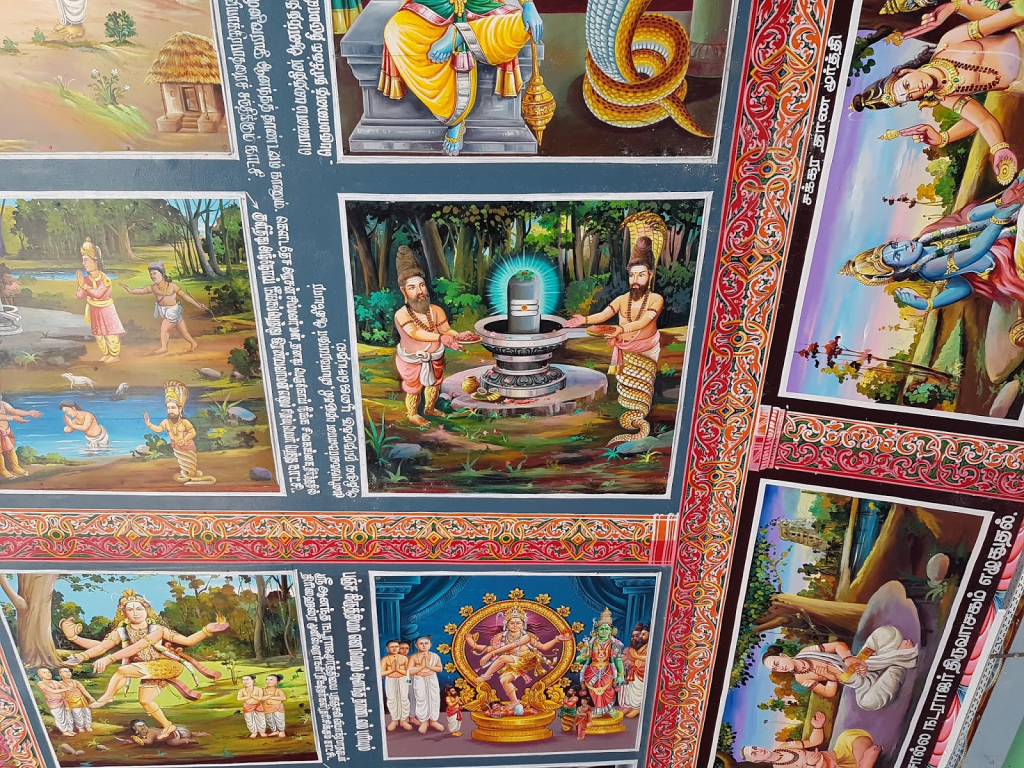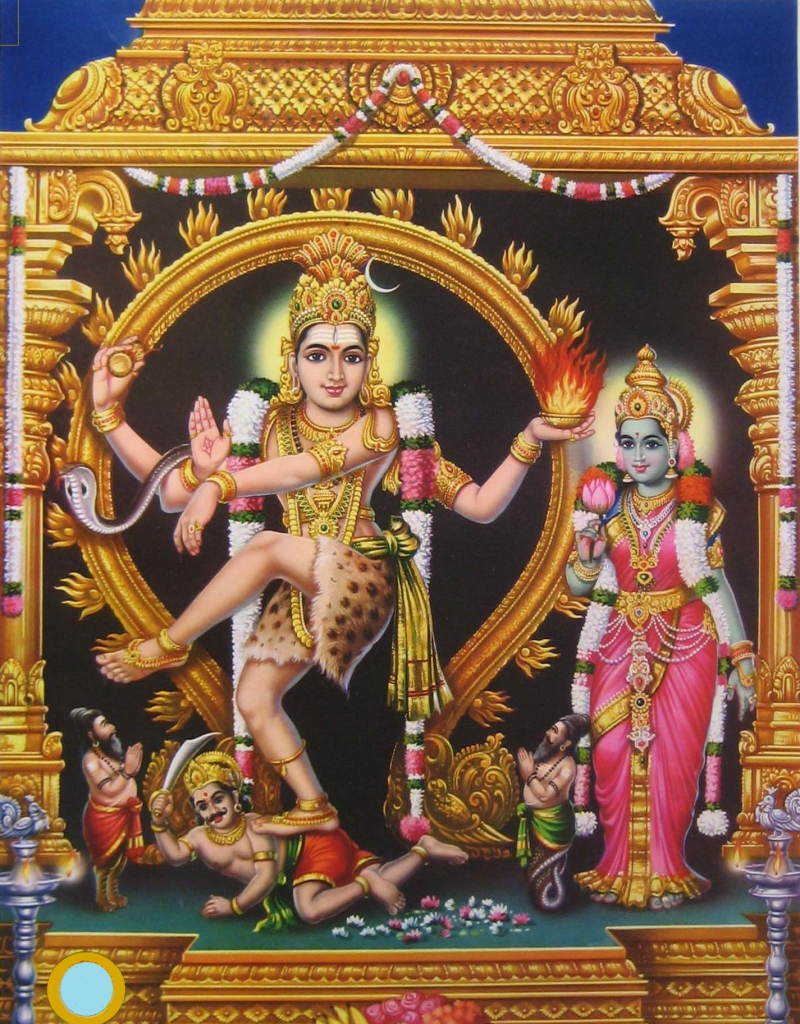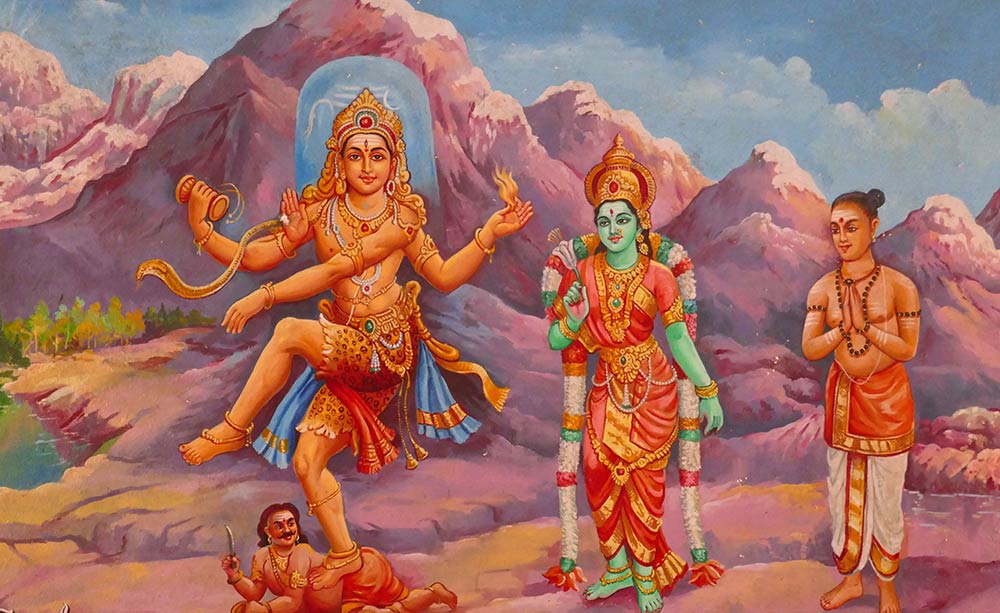Introduction:
Deeply entrenched in rich cultural heritage and spiritual significance, the Chidambaram Sri Nataraja Temple stands as a magnificent testament to Tamil Nadu’s glorious past. As one ventures into this sacred abode of Lord Nataraja, they are captivated by the temple’s awe-inspiring mural paintings that adorn its walls. These extraordinary artworks bring to life the stories from the Tamil Tiruvilaiyadal Puranam, a collection of mythical tales that celebrate the divine plays of Lord Shiva. Join us on an enchanting journey as we unravel the beauty and significance of these mesmerizing mural paintings.

The Divine Dance of Lord Nataraja:
At the heart of the temple’s mural collection lies the portrayal of Lord Nataraja, the cosmic dancer. With graceful movements and intricate postures, these paintings depict the essence of Lord Shiva’s celestial dance, the Ananda Tandava. The vibrant colors and meticulous detailing lend a divine aura to these artworks, symbolizing the eternal cycle of creation and destruction.

Tales of Divine Intervention:
The mural paintings in Chidambaram Sri Nataraja Temple delve into the captivating stories from the Tamil Tiruvilaiyadal Puranam. Each painting captures a momentous event where Lord Shiva, in various forms and avatars, manifests on earth to bestow his blessings or test the devotion of his devotees. From his playful interactions with saints and sages to his divine interventions in mortal affairs, these murals bring these mythological tales to life.

The Legend of Saint Manikkavachakar:
One of the prominent tales depicted in the temple’s murals revolves around the life and miracles of Saint Manikkavachakar. Known for his profound devotion to Lord Shiva, the murals beautifully narrate the story of how the saint, through his unwavering love and unwavering faith, performed miracles and triumphed over adversities. The paintings serve as a source of inspiration, reminding devotees of the power of devotion and the triumph of good over evil.
Depicting Divinity and Cosmic Rhythms: The Mural Art of Nataraja Temple in Chidambaram:
The murals in the Nataraja Temple at Chidambaram are a splendid representation of Hindu mythology ‘Thiruvilaiyadal Puranam’, focusing significantly on Lord Shiva, to whom the temple is devoted. These murals are not only an artistic treasure but also a cultural and spiritual narrative painted on the walls of this ancient temple.
- Depiction of Lord Shiva: Central to these murals is Lord Shiva, venerated here in his iconic form as Nataraja, the Lord of Dance. This representation of Shiva is profoundly symbolic in Hinduism, illustrating the cosmic cycles of creation and destruction, as well as the harmony of life. The murals capture Shiva’s dynamic and cosmic dance, portraying him in various postures of the Ananda Tandava, the dance of bliss.
- Scenes from Hindu Mythology: The murals are richly imbued with scenes from Hindu mythology, particularly from ancient texts like the Puranas. These stories are not mere tales but are imbued with deep philosophical and spiritual meanings. They depict various episodes from Shiva’s life – his role as a creator, preserver, and destroyer, his marriage to Parvati, and his interactions with other deities.
- Artistic Style and Symbolism: The style of these murals is typically South Indian, characterized by vibrant colors, intricate details, and a sense of movement and rhythm. The use of symbolism is profound – for instance, Shiva’s dance is not just a physical act but a symbol of the rhythmic movement of the cosmos. The depiction of other deities, sages, and celestial beings in these murals also adds layers of meaning and context to the central theme of Shiva.
- Cultural Significance: These murals serve as a visual sermon, educating and enlightening the devotees about the greatness of Lord Shiva. They are an essential part of the temple’s cultural heritage, reflecting the artistic, religious, and philosophical ethos of the time when they were created.
- Spiritual Experience: For devotees and visitors, these murals are not just art; they are a medium for spiritual connection. The depiction of Shiva in various forms and actions serves as a reminder of the divine presence and the eternal truths represented by Hindu mythology.
In conclusion, the murals in the Nataraja Temple are a magnificent blend of art, spirituality, and mythology, offering a vivid window into the rich tapestry of Hindu traditions and beliefs centered around Lord Shiva.

Celebrating Tamil Culture and Heritage:
Beyond their mythological significance, the mural paintings of Chidambaram Sri Nataraja Temple also celebrate the vibrant Tamil culture and heritage. The artistic style, influenced by the Nayak dynasty, showcases intricate detailing, vibrant colors, and fluid brushstrokes. From showcasing ancient Tamil architecture to highlighting cultural practices and festivals, these murals provide a glimpse into the region’s rich history and cultural tapestry.

Preservation and Restoration Efforts:
Preserving and restoring these invaluable mural paintings is a labor of love and devotion. Over the years, dedicated teams of art restorers and conservationists have worked tirelessly to maintain the original beauty and integrity of these artworks. With advancements in technology and conservation techniques, the murals have been protected from the ravages of time, ensuring that future generations can continue to marvel at their magnificence.

Conclusion:
The mural paintings of Chidambaram Sri Nataraja Temple offer a visual feast for art enthusiasts, history buffs, and spiritual seekers alike. These exquisite artworks not only narrate the tales from the Tamil Tiruvilaiyadal Puranam but also serve as a testament to the rich cultural heritage of Tamil Nadu. As we stand in awe of the artistic brilliance and divine tales depicted on the temple’s walls, we are reminded of the enduring legacy of these ancient masterpieces and the timeless spiritual wisdom they convey.

